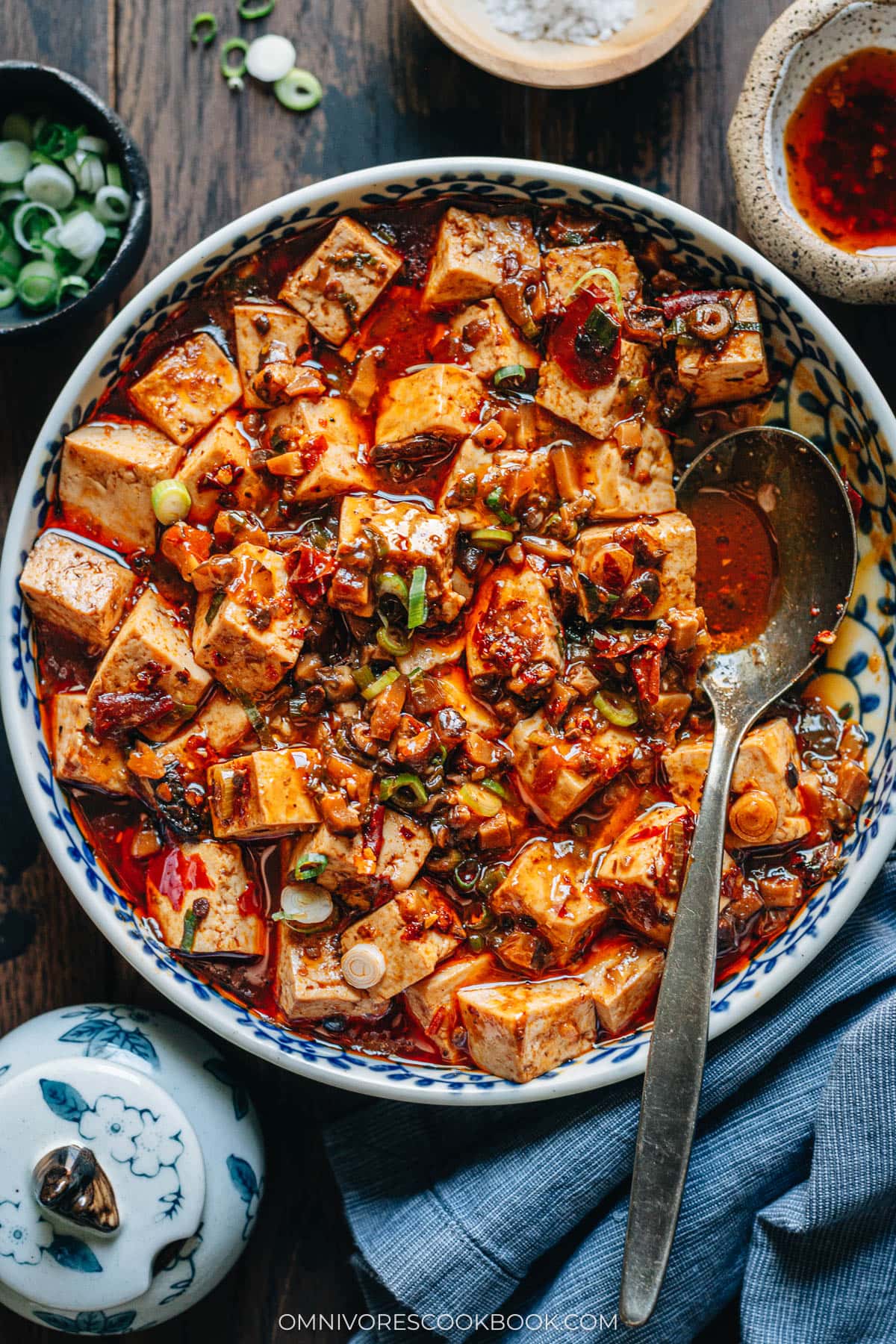
In the past I’ve shared a recipe for authentic Sichuan mapo tofu, which is rich and flavorful thanks to the added ground meat. But sometimes I might run out of meat or just want a lighter dinner. That’s why I developed this vegetarian mapo tofu, which uses pantry ingredients I always have on hands. The cooking process is quite similar to that of the original mapo tofu, but it still yields a hearty and satisfying result.
To make a rich tasting vegetarian mapo tofu, I used dried shiitake mushrooms and their soaking water for an intense umami. I also used homemade fermented black bean sauce to give it extra depth of flavor. Soft (or even silken) tofu is often used in Chinese restaurant for the best texture, so did I here. But feel free to replace it with medium or firm tofu if you prefer.
Ingredients
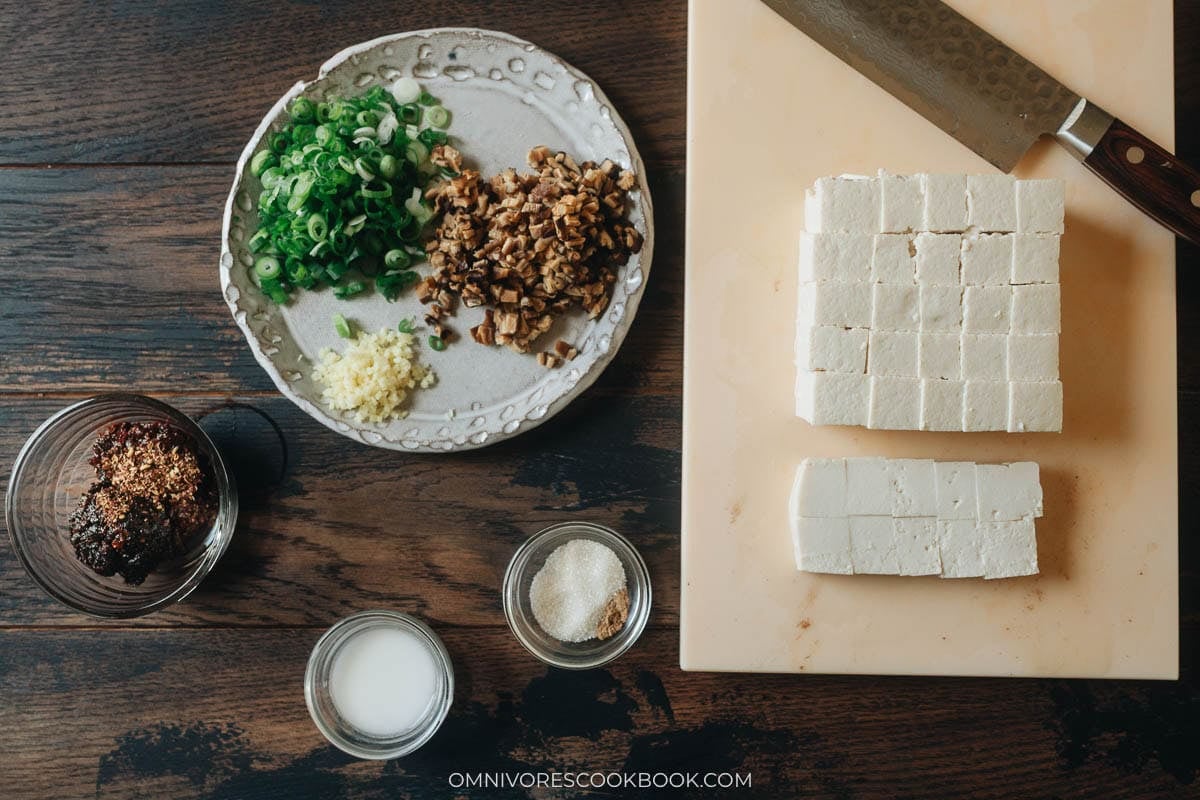
It might seem like vegetarian mapo tofu calls for quite a few specialty ingredients. But most of them are easy to source these days, even if you don’t have access to Chinese markets. And they are great pantry staples that you can use again and again to create very authentic tasting Sichuan food and other Chinese dishes.
Doubanjiang
Doubanjiang (豆瓣酱) is a super rich, fermented, spicy paste. It adds a deep savory, spicy, and salty taste to the dish to create that signature taste of mapo tofu. This is a must-have in your pantry, if you like cooking Sichuan food.
You can find it in an Asian market, on Amazon, or at Mala Market.
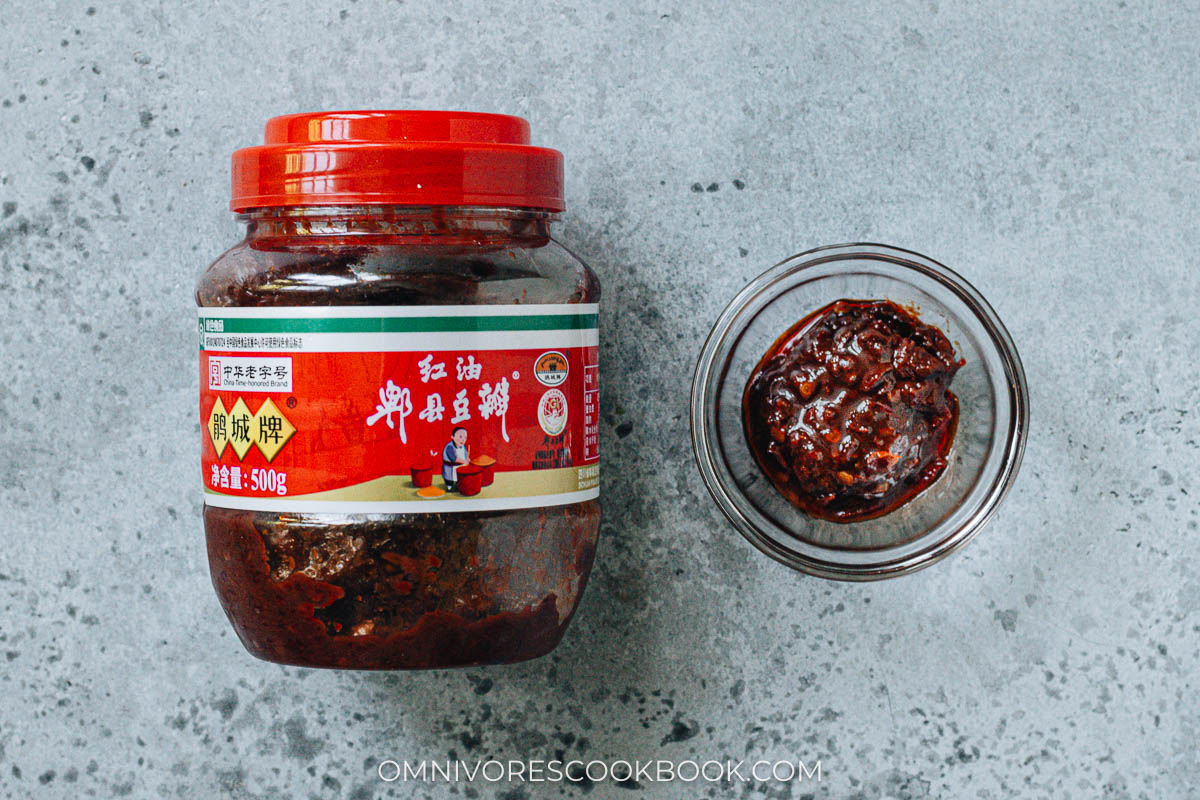
Sichuan peppercorns
Sichuan peppercorn (Hua Jiao, 花椒) is another key ingredient to give mapo tofu that numbing tingling sensation. I consider it as important as doubanjiang to create the authentic taste.
For this ingredient, freshness is the key since it start to lose its potency quite quickly after harvesting. I highly recommend you purchase Sichuan peppercorns from Mala Market. They carry the freshest Sichuan peppercorns in the US, sourced directly from Sichuan. It truly makes a world of difference.
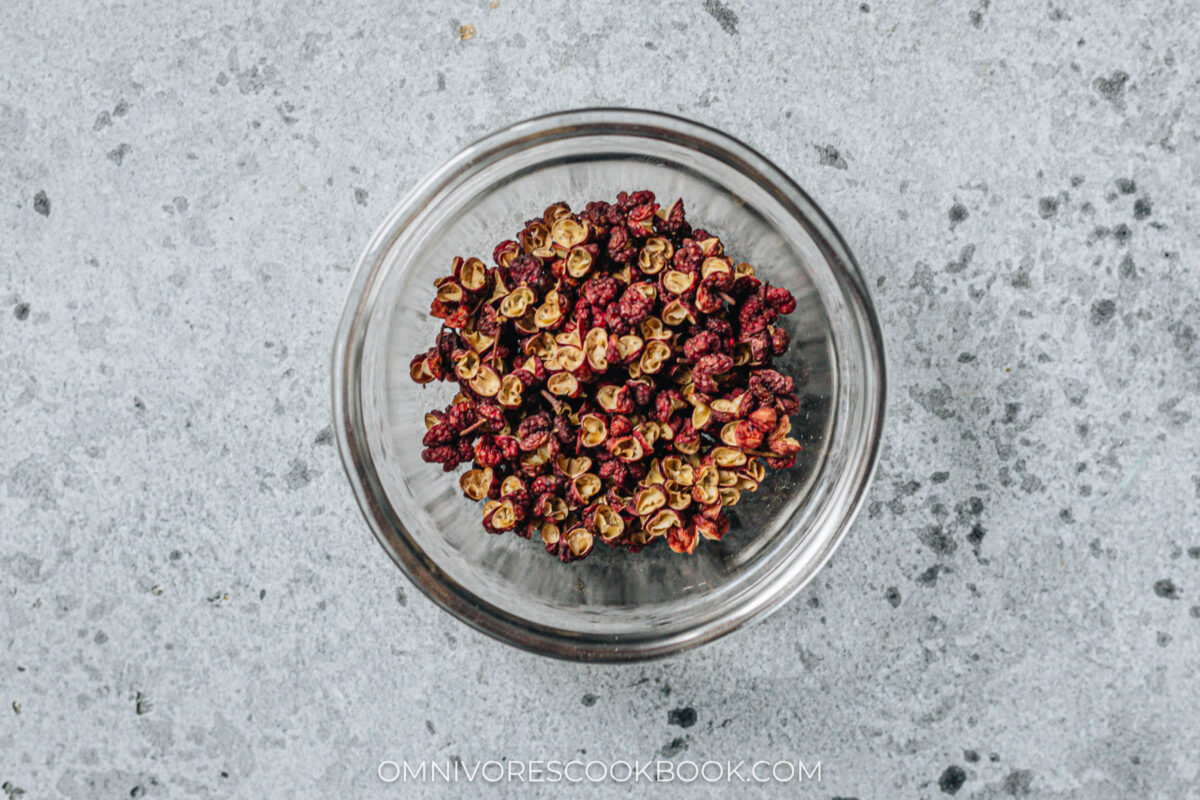
Fermented black bean sauce
Fermented black bean sauce, or Douchijiang (豆豉酱) in Chinese, is a rich fermented sauce that is very savory. The flavor is like that of soy sauce, but with an even stronger fermented fragrance and much more dimension. It is not a default ingredient for mapo tofu, but I prefer to use it in this vegetarian version, to boost the flavor.
You can either buy it pre-made from the store or make your own. (Making your own is way better! But I understand if you’re pressed for time.)
Dried Shiitake Mushrooms
While dried shiitake mushrooms aren’t as uncommon as the Sichuan ingredients discussed above, they’re crucial to giving the dish a big, mouth-filling umami.
The traditional version of this dish uses ground pork, and I’m happy to let you know that dried shiitake mushrooms pack just as much savory goodness.
You’ll rehydrate the mushrooms, mince them up, and use the rehydrating water as broth for the sauce. It’s an easy way to get huge flavor, and it works perfectly here.
How to make
Soak the shiitake mushrooms to rehydrate it. In China, we always soak the shiitake mushrooms in cold water, to preserve its flavor. It will take 2 to 3 hours. If you’re short on time, you can use warm water that is not too hot too touch. The mushrooms rehydrate in 15 minutes or so this way. Do not use boiling water, because it’s too hot and will cause the mushroom losing a lot of umami.
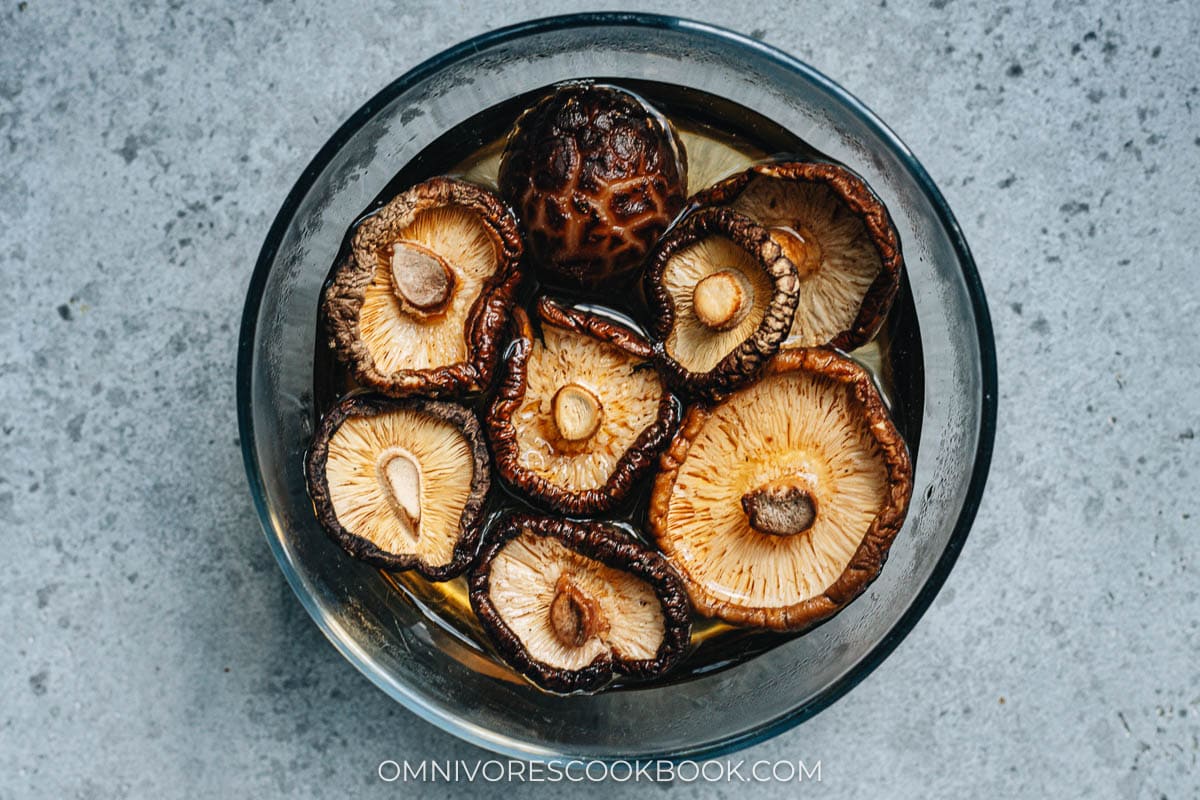
To cook, toast the doubanjiang, black bean paste and Sichuan peppercorns in the oil until the doubanjiang releases red oil. This step draw the rich flavor from the ingredients and make the oil very fragrant.
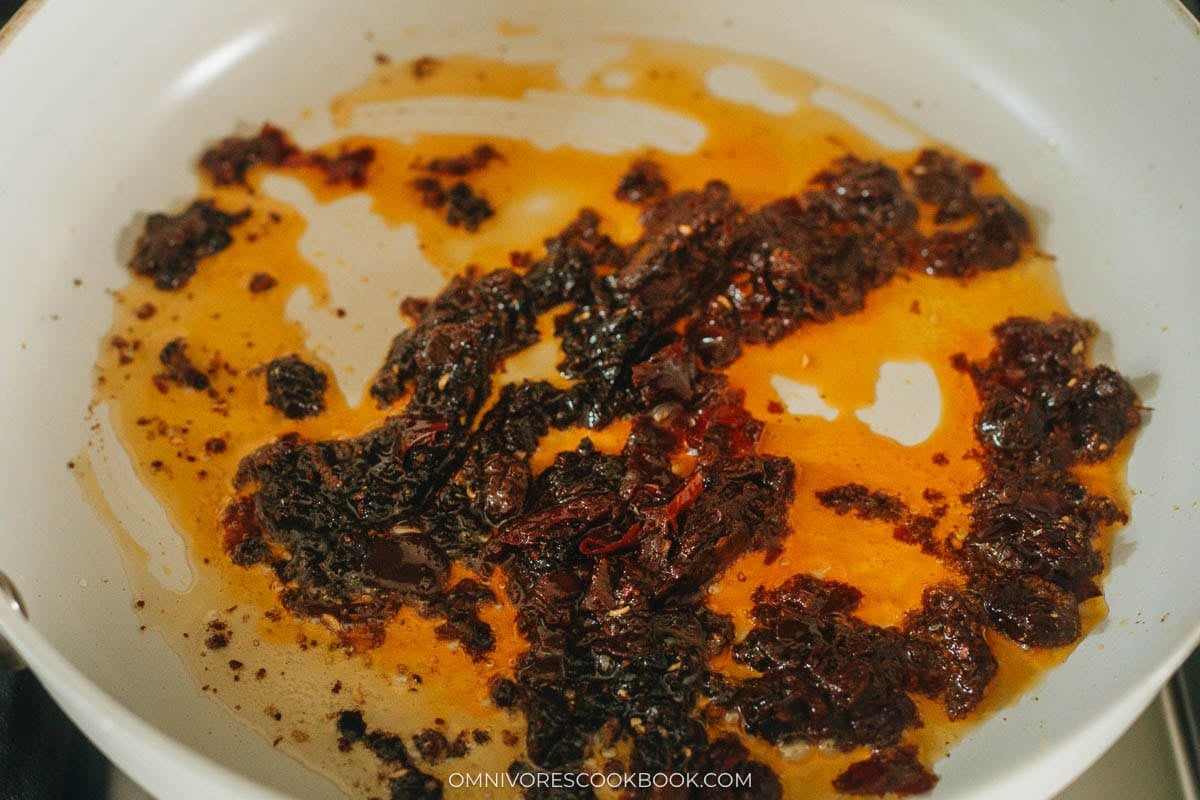
Next, cook the aromatics to further add fragrance to the base.
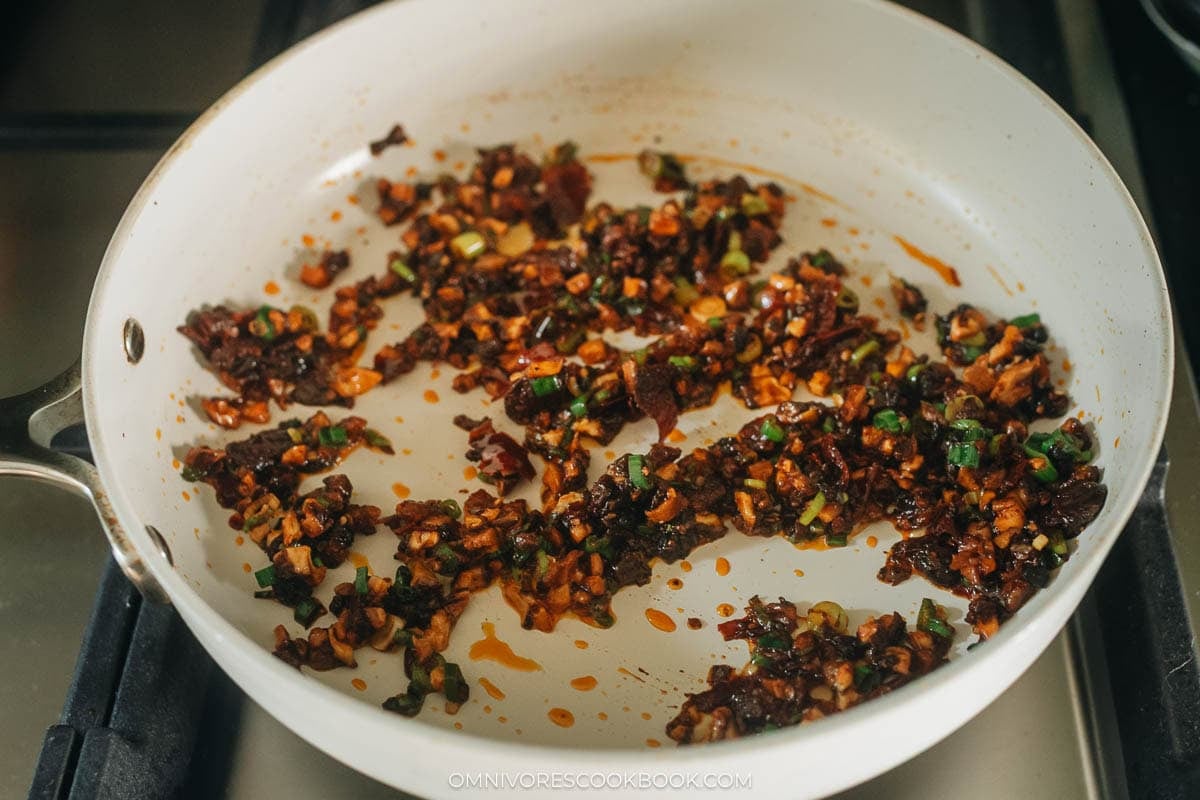
Then braise the tofu with the rest of the braising ingredients. If using soft tofu like I did here, you only need to briefly simmer the tofu, a few minutes or so. If using firm tofu, you can cover the pan and let braise a little longer, 10 to 15 minutes, so the tofu soak up more flavor.
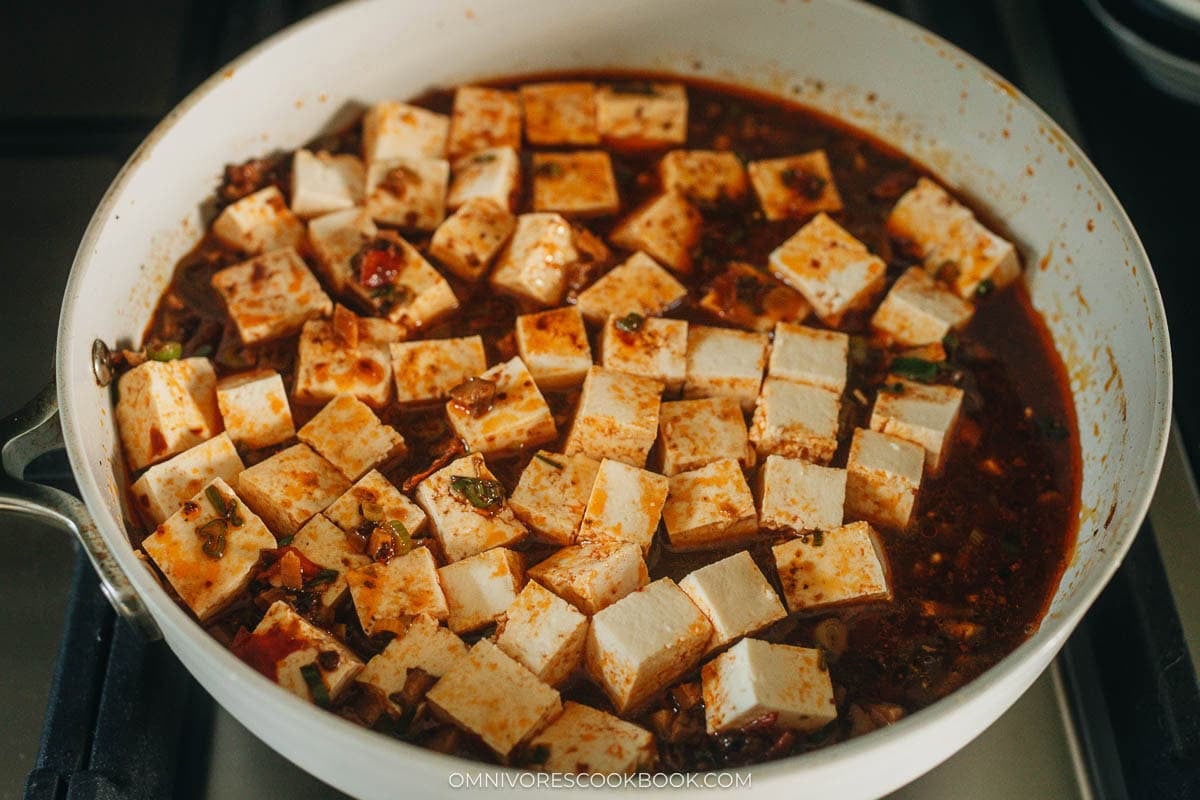
Lastly, stir in the cornstarch slurry to thicken the sauce. This is a step where you can adjust the texture of the sauce. Always pour in the slurry slowly and stir to activate the cornstarch thickening power. You can add less if the sauce thickens already, or make more slurry if the sauce is still too thin.
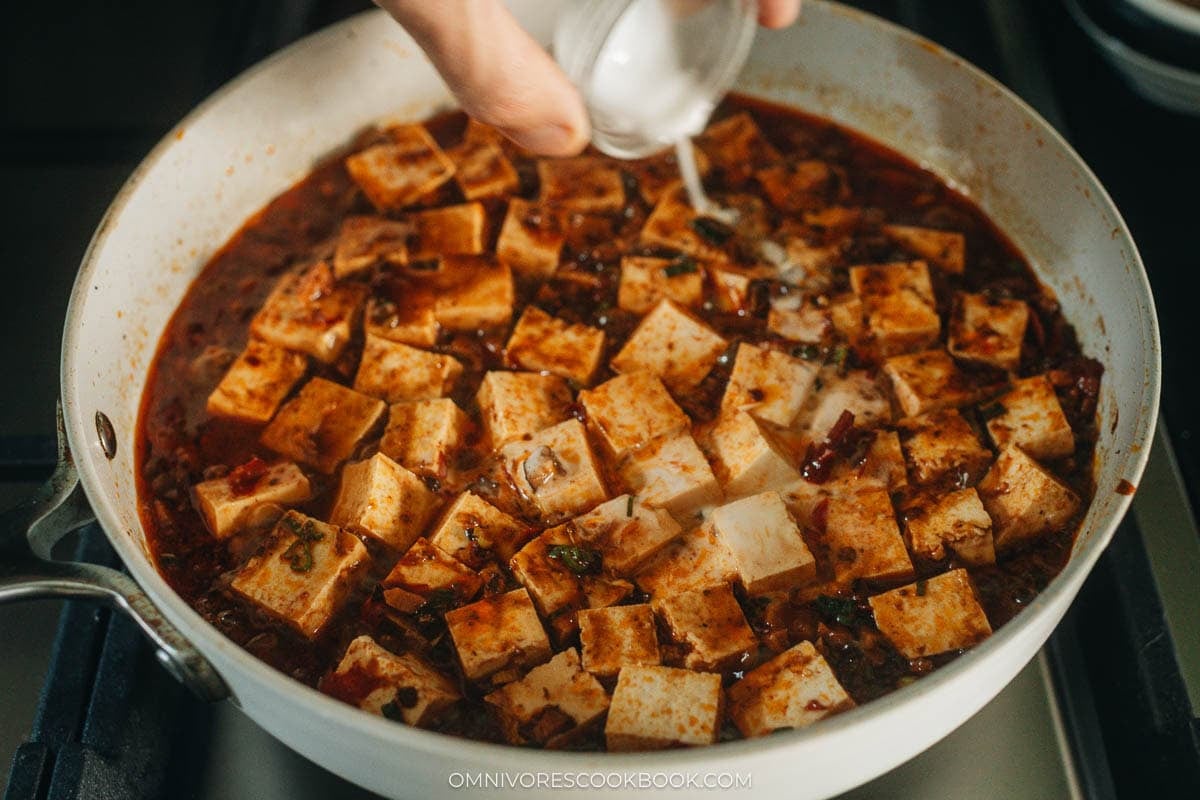
Lastly, you can garnish the dish with more ground Sichuan peppercorns and chili oil, to recreate the authentic taste and presentation just like the dish from Chinese restaurants.
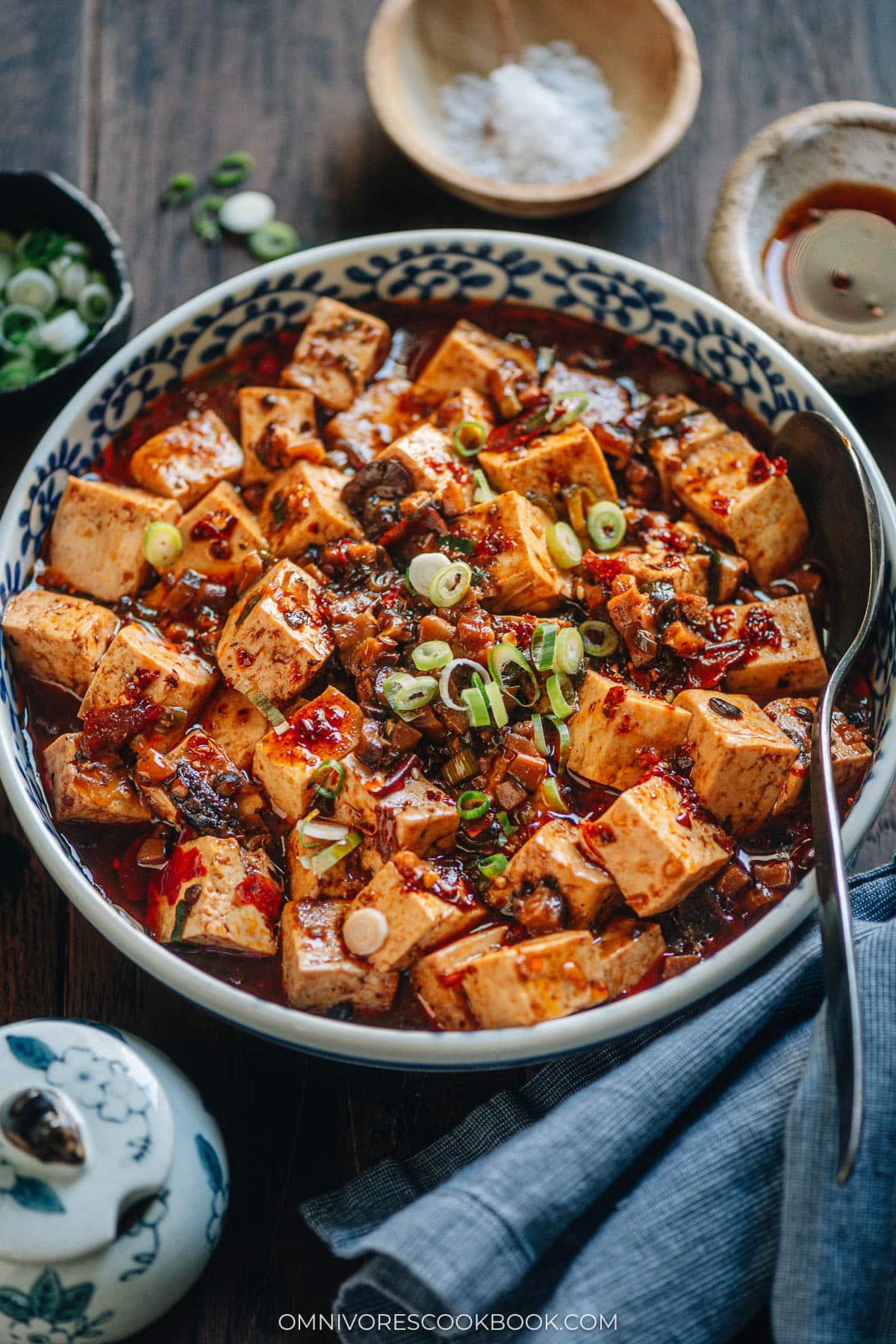
Need more veggies?
It’s not shown in the pictures here, but sometimes I add a batch of spinach or baby bok choy at the end of the cooking, just to add some greens to my meal. It only takes a few seconds to cook through the veggies and it’s super tasty. It’s extra convenient if you’re cooking for one, to make a very nutritious one-pot meal.
How to serve
I always enjoy serving vegetarian mapo tofu over steamed brown rice. You can also serve it with noodles, since it has a good amount of sauce to soak the noodles in. For other appetizers, soups and main dishes that accompany this dish, consider serving it with:
- Vegan Egg Drop Soup
- Vegetarian Hot and Sour Soup
- Spinach Stir Fry
- Vegan Dan Dan Noodles
- Vegetarian Chow Mein
- Wood Ear Mushroom Salad
That’s it! I hope you find the recipe easy to follow and the results rewarding!
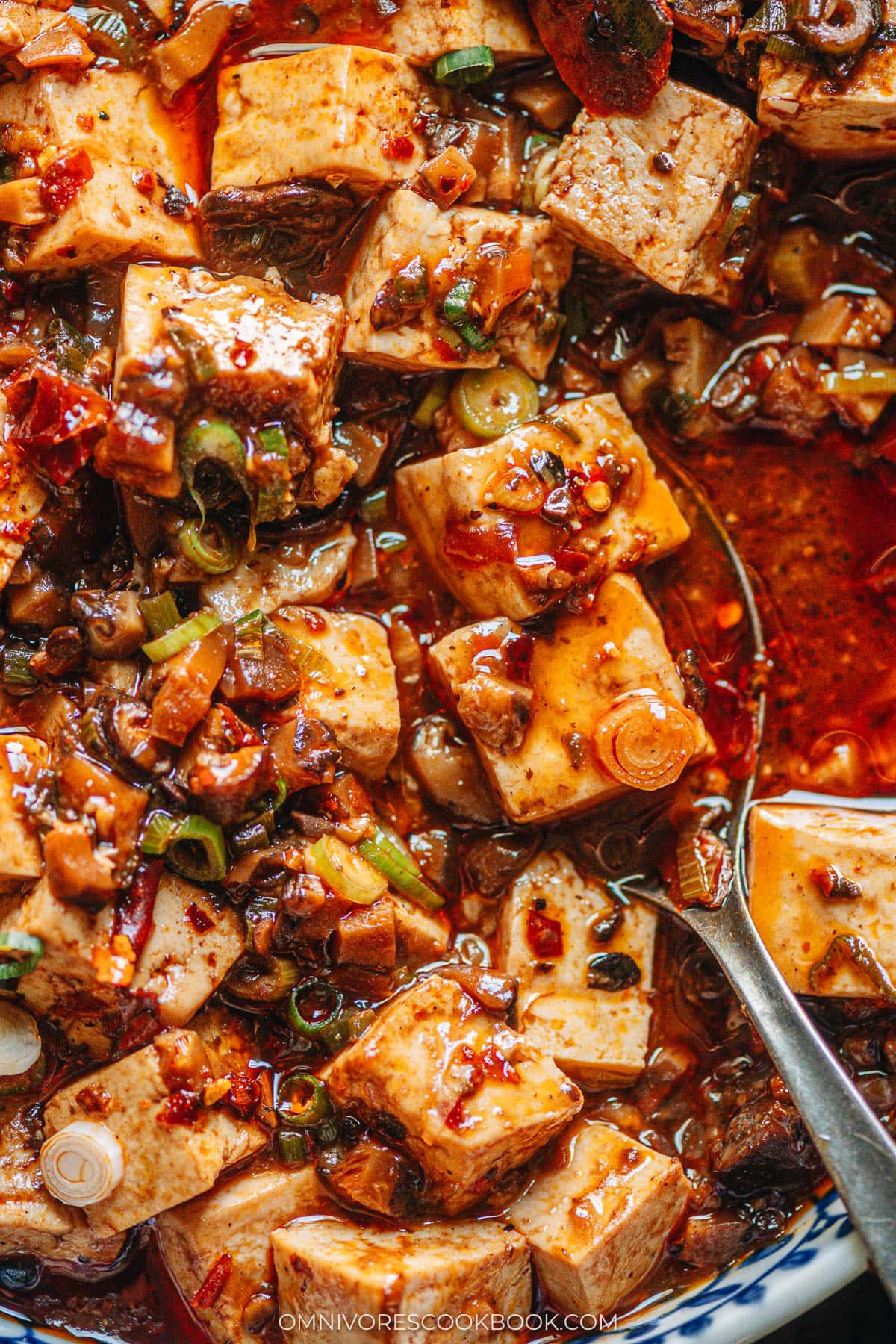
Frequently asked questions
Can I make it ahead of time?
Yes. If you plan to make this dish ahead of time, firm tofu works better than soft tofu.
Can I make it less oily?
Yes, you can reduce the oil, but some oil is needed to “bloom” the doubanjiang, which helps release aroma and color. Try starting with 1 tablespoon instead of the traditional 2 to 4 tablespoons.
I like your old version for this dish. Where can I find it?
I used regular button mushrooms instead of shiitake in my previous recipe. You can find the previous version at the bottom of this post, by scrolling past the recipe card below.
Chinese Cooking Made Easy
Are you new to this website? This free email series is a great place to start. I’ll walk you through a few of my most popular recipes and show you how and why they work. You’ll quickly start to cook better Chinese food in your own kitchen.
Watch video
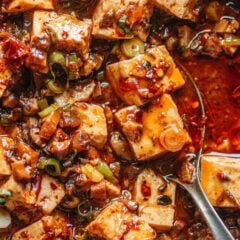
Vegetarian Mapo Tofu
Ingredients
- 4 large dried shiitake mushrooms (or 6 small)
Spice mix
- 2 tablespoons Doubanjiang
- 1 tablespoon homemade black bean sauce (or store-bought sauce)
- 1/4 teaspoon freshly coarsely ground Sichuan peppercorns , and extra for garnish
Cooking
- 2 to 3 tablespoons peanut oil (or vegetable oil)
- 2 green onions , sliced
- 1/2 " ginger , minced
- 2 teaspoons Shaoxing wine
- 1 cup mushroom soaking water
- 1 block soft tofu (16 ounces / 450 g per block) , cut into ½ inch (1.5 cm) cubes (*Footnote 1)
- 1/8 teaspoon five-spice powder
- 1 teaspoon sugar (or to taste)
Slurry
- 1 teaspoon cornstarch
- 1 tablespoon water
Garnish
- Homemade chili oil (Optional)
Instructions
- Add the dried shiitake mushrooms into a small bowl and add 1 cup hot water to cover. Let soak for 20 minutes, or until the mushrooms turn soft throughout. Squeeze out excess water and rub off any debris from the mushrooms. Finely chop the mushrooms into ¼ inch (1/2 cm) squares. Reserve the soaking water for later use.
- Combine the spice mix ingredients in a small bowl.
- Heat 2 Tablespoons oil in a large nonstick skillet over medium heat until warm. Turn to medium-low heat and add the spice mix. Cook and stir for 1 minutes.
- Add the chopped shiitake mushrooms, green onion, and ginger. Cook and stir until the aromatics are lightly browned and the oil starts to turn an orange red hue. Add more oil if the pan looks too dry.
- Pour in the Shaoxing wine and quickly use your spatula to release any brown bits from the pan.
- Pour in the mushroom soaking water, being careful not to add the debris from the bottom of the bowl.
- Add five spice powder and sugar. Mix a few times to dissolve.
- Carefully spread the tofu in the broth in a single layer. Turn to medium-high heat and bring to a simmer. Turn to medium-low heat again and simmer for 5 minutes.
- Meanwhile, make the slurry by whisking cornstarch with water in a small bowl until completely dissolved. Swirl half of the mixture into the tofu, stirring gently with a spatula. Add more until the sauce reaches the desired consistency. Taste a piece of tofu with some sauce. Add more sugar to balance the taste if it is too spicy for you. Transfer everything to a big plate.
- (Optional but highly recommended) If you want your dish to look like the authentic mapo tofu in Sichuan, swirl in a few tablespoons of homemade chili oil and sprinkle with a generous amount of freshly ground Sichuan peppercorns at the end of the cooking, to give the sauce a beautiful red color and a bright numbing zesting taste.
- Serve over steamed rice as a main.
Notes
- Soft tofu is a bit tricky to handle but it creates the proper restaurant-style texture. You can totally replace it with firm or medium tofu and still get a great result.
Nutrition

Did you make this recipe?
I’d love to hear how it turned out for you! Please take a moment to leave a 5-star rating ⭐️ and share your thoughts in the comments further down the page. It really helps others discover the recipe too.
The recipe was updated with major changes in 2021. If you want the older version, see the recipe below.
Vegetarian mapo tofu (old version)
INGREDIENTS
Spice mix
- 2 tablespoons fermented black beans
- 2 tablespoons Doubanjiang (spicy fermented bean paste)
- 1 teaspoon Chinese chili flakes
- 1/4 teaspoon ground Sichuan peppercorns
Cooking
- 2 to 3 tablespoons peanut oil (or vegetable oil)
- 2 green onions, chopped
- 1 tablespoon minced ginger
- 2 cloves garlic, minced
- 2 cups vegetable stock
- 1 (450-g / 16-oz) block medium-firm or firm tofu, cut into 1/2-inch (1.5-cm) cubes
- 1/2 lb (225 g) mushrooms, sliced
- 1/8 teaspoon five-spice powder
- 1 teaspoon sugar or to taste
- 1 tablespoon cornstarch
- (Optional) Homemade chili oil, for garnish
INSTRUCTIONS
- Add fermented black beans to a small bowl. Add water to cover, gently rub a few times with your fingers, and drain well. Use the back of a small spoon to smash the beans into smaller bits. Add the doubanjiang, chili flakes, and Sichuan peppercorns to the same bowl.
- Heat 2 tablespoons oil in a large skillet over medium heat until warm. Add green onion, ginger, and garlic. Stir a few times to release the fragrance.
- Add the spice mix from step 1. Cook and stir for 1 to 2 minutes, until the paste is cooked through and very fragrant. If the paste starts to stick to the pan, add a bit more oil or some vegetable broth and use your spatula to release any stuck bits.
- Add the mushrooms. Cook and stir for 2 minutes or so, until the mushrooms are evenly coated with the spices. Add a bit of vegetable broth if it start to stick.
- Add the vegetable stock, five spice powder, and sugar. Stir to mix well and bring to a simmer.
- Spread the tofu in the broth in a single layer. Turn to low heat and simmer for 10 to 15 minutes or so.
- Whisk cornstarch with 3 tablespoons water until completely dissolved. Swirl half of the mixture into the tofu, stirring gently with a spatula. Add more until the sauce reaches the desired consistency. Taste a piece of tofu with some sauce. Add more sugar to balance the taste if it is too spicy for you. Transfer everything to a big plate.
- (Optional) If you want your dish to look like the authentic mapo tofu in Sichuan, swirl in a few tablespoons of homemade chili oil at the end of the cooking, to give the sauce a beautiful red color.
- Serve over steamed rice as a main.

Nina
I’ve made this recipe and its meaty version many times and always love it. It’s easy to add a fresh vegetable (I like yu choy or lightly cooked broccoli added right after the mushrooms). I also add fermented black beans if I have them. Last night, I tried firm tofu that I pressed before cooking – definitely not traditional, but we enjoyed how the tofu stayed more distinct in the dish.
Samson
Made this with the egg fried rice recipe from this site, combination was absolutely amazing!
Jerry
Really benefited from adding peanuts; broke up the soft texture monopoly of the dish and gave it a great earthy counter note. We also subbed mushrooms (neither of us like those) for roasted seaweed; gave a decent umami. Otherwise very solid recipe!
Sophie’s Mom
I used your recipe to save a not-so-good carry-out Mapo Tofu I got from a restaurant the other day. It did the trick! I won’t bother with getting it to go anymore, if I can make it this good at home. Thank you!
Keith
This was excellent. I made it exactly according to the recipe.
Heath
Wow! This was my first time making mapo tofu and I was surprised by how simple it was. It tasted SO close to what I’ve had in restaurants—and I was missing the black bean sauce, so I suspect that would have gotten it there. Thank you for this recipe! I will definitely be making it again.
Stez Stezic
The old version is far superior and packs much more of a punch.
Carolyn Brodersen
Maggie–I first made a batch of your wonderful Salt & Pepper Tofu, only skipping the spice mixture at the end. Then I added that crispy tofu to the Vegetarian Mapo Tofu–and only let it boil for a short time. Ta-da–slightly crispy and umami-like tofu cubes that have a meat-like texture, complete with a tender skin. Thanks for the inspiration. I adore your blog!
Brigitte
Absolutely loved this recipe! So tasty and easy to make. The only thing was that there wasn’t much sauce at the end so I’d probably add a bit more spice mix + water next time.
Steph Edwards
Really tasty – def be making again and again – though I did add some Chinese cabbage to add some crunch. Might use semi-firm tofu next time as the soft tofu just broke up.
Soner Ali
Recipe was nice but I prefer the original veg.mapo tofu, which you seem to have taken down,can you put the old recipe back up.
Thanks.
Tommy
Fantastic veggie Mapo tofu. We’re totally addicted and have made it over 10 times now for many, many friends. It’s mind blowing.
Sabine
This recipe looks absolutely delicious! Ican’t wait to try this. I don’t have any fermented black beans on hand. Have you tried leaving them out or do you think the recipe would work without them?
Maggie
Hi Sabine, yes you can leave out the fermented black beans. It is similar to soy sauce with a different note, but you can cook the dish without it.
Divya Annamraju
Hi Maggie, I made this recipe a few weeks ago after getting my hands on some bean paste and Doubanjiang at a local Chinese grocery store. Wow! I was totally blown away by the flavors in the dish and my husband was equally impressed. I had not guessed how complex the preparation of these ingredients is. It made my cooking relatively easy for an incredible dish. I’m making a variant of this tonight and excited to try it. Your website is now my go to for Chinese cooking!
Kirsten
I have just made it for dinner and it is delicious! Better than any I have eaten in restaurants which are always too oily and too garlicky. The only thing I changed was, I cooked the onion, ginger and garlic in water instead of oil. I wanted to check if it changes the taste at all, the change is so minor that I can totally do without the oil. Instead of chilli oil I also just used dried chilli flakes. Its quite salty so I have not seasoned the rice or the wilted spinach and courgettes, which balances out the saltiness. Thank you for another great recipe…
Flower
Would dried shiitake mushrooms be an acceptable substitute for fresh mushrooms in this recipe?
Nami
I got a large jug of anchovy sauce (kknari) from a Korean market but do not know what recipes it is used for. Do you?
danielle
I am in love with all the great flavors here. I love both the spicy bean paste and fermented black beans. I keep them along with my shrimp paste, kimchi and all the other goodies in my fridge. That stuff just has so much flavor. Great tip on the szechuan peppercorns – I’ll have to check that place out.
Tina
That looks so good! We have an amazing Chinese restaurant near us and they are from Chengdu. They make a wonderful Mapo Tofu but they do use a metric ton of oil. A lighter version sounds great. I look forward to trying this.